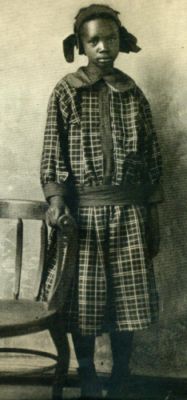Sarah Rector facts for kids
Quick facts for kids
Sarah Rector
|
|
|---|---|

Rector in 1912
|
|
| Born | March 3, 1902 Indian Territory now Taft, Oklahoma, U.S.
|
| Died | July 22, 1967 (aged 65) Kansas City, Missouri, U.S.
|
| Resting place | Blackjack Cemetery, Taft, Oklahoma, U.S. |
| Education | Tuskegee University |
| Spouse(s) |
|
| Children | 3 |
Sarah Rector (March 3, 1902 – July 22, 1967) was an amazing person known as the "Richest Colored Girl in the World." She was a citizen of the Muscogee Nation and became very wealthy because of oil found on her land.
Contents
Early Life and Land Allotment
Sarah Rector was born in 1902 near Taft, Oklahoma, a town where only Black people lived. This area was then called Indian Territory. She had five brothers and sisters.
Her parents, Rose McQueen and Joseph Rector, were grandchildren of Muscogee people. After the American Civil War, they were listed as "freedmen" on special government lists called the Dawes Rolls. This meant they were given land by the United States government.
Many Black children, including Sarah, received land. Sarah was given about 159 acres of land. This was part of a plan to combine the Indian Territory with Oklahoma Territory to create the state of Oklahoma.
The Oil Discovery
Sarah's land was in Glenpool, Oklahoma, about 60 miles from her home. People thought the land was not good for farming. Better land was usually given to white settlers or other tribe members.
Sarah's family was not poor, but they struggled to pay the $30 yearly tax on her land. Her father, Joseph, asked the court if he could sell the land, but he was not allowed to.
To help with the taxes, in 1911, Joseph Rector leased Sarah's land to the Standard Oil Company. In 1913, an oil driller named B.B. Jones drilled a well on the property. Suddenly, a huge "gusher" of oil shot out! This well started producing about 2,500 barrels of oil every day.
Sarah began to receive $300 a day from this oil. This was a huge amount of money back then!
A Guardian for Her Wealth
Because Sarah was so young and had so much money, the law said she needed a "well-respected" white guardian to help manage her wealth. So, a local white resident named T.J. Porter became her guardian instead of her parents.
News of Sarah's wealth spread all over the world. Even though she was only 12, she started getting requests for loans, money, and even marriage proposals!
In 1913, the Oklahoma Legislature even tried to declare her white. This would have given her more social benefits, like being able to ride in first-class train cars.
Protecting Sarah's Future
In 1914, an African American newspaper called The Chicago Defender became interested in Sarah's story. There were rumors that her family was mismanaging her money and that she was not being cared for properly.
Important African American leaders like Booker T. Washington and W. E. B. Du Bois became worried about her. An agent from the National Association for the Advancement of Colored People (NAACP) investigated her situation. He was concerned that her white guardian might not be looking out for her best interests.
Because of this, Du Bois started the Children's Department of the NAACP. This group would investigate cases where white guardians might be taking advantage of Black children's land and money. Booker T. Washington also helped Sarah's family.
In October 1914, Sarah was sent to the Children's School at the Tuskegee Institute in Alabama. This was a special boarding school. After she finished school there, she went on to attend the Institute itself.
Life as a Millionaire
By the time Sarah turned 18 in 1920, she was already a millionaire! She owned many things, including stocks, bonds, a boarding house, other businesses, and a large piece of land.
After graduating, she left Tuskegee and moved with her family to Kansas City, Missouri. She bought a big house there on 12th Street, which is now known as the Rector House. People are working to restore it and preserve its history.
Soon after moving to Kansas City, when she was about 17 or 18, Sarah married a local businessman named Kenneth Campbell in 1920. They had three sons. Later, in 1934, she married a restaurant owner named William Crawford.
Later Life
Sarah Rector lived a very comfortable life. She loved nice clothes and cars and enjoyed her wealth. She hosted grand parties and entertained famous people like Count Basie and Duke Ellington.
Sarah Rector passed away on July 22, 1967, when she was 65 years old. She is buried in Blackjack Cemetery in her childhood hometown of Taft, Oklahoma.

